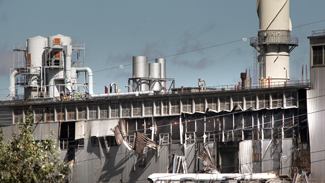CRVC’s hearing on Development Agreement suit
October 7th, 2010
(really, that’s their “site plan” — how informative!!)
It’s in the news, Concerned River Valley Citizens’ suit against LS Power, Lent Township and Chisago County had a hearing last week. Short version:
Judge Hoffman said he wanted to be armed with sufficient information to make a decision. He asked for just one thing – a written transcript of the legislative discussion that preceded the adoption of the legislation regarding the tax exemption in 2009, specifically subdivision 92 pertaining to the obtaining of the development agreement.
He asked the attorneys to write a letter to the court when it is provided and then he will make his decision.
The judge believed this information is important and he can’t be obligated to make a decision until he knows what the legislation said about approval of a development agreement “before” the start of construction.
Most committee meetings now are available online, and the legislative library provides tapes. One problem is that the legislative intent is rarely conveyed in the committee meetings, and all the behind the scenes doings aren’t going to see the light of day.
The statutory section at issue – Minn. Stat. 272.02, Subd. 92.
Here’s the Summons and Complaint from last June:
For more info, go to www.stopsunriseriverplant.com
From ECM Post Review:
Judge asks for one thing in power plant civil case
BOOM! at Xcel’s Black Dog plant
September 22nd, 2010
An “ignition event” in the coal hopper, more commonly called an explosion and fire… Three firefighters on the scene were injured when it blew after they arrived.
This’ll be old news, but I’ve been incommunicado for a while, lost in the mountains of the Northwest, where there is no cell, no internet… what a concept!
Photo by Bill Klotz, Finance & Commerce (Fair Use!)
An interesting quote:
Here’s some video from KARE 11 with shots of the exterior damage:
In the St. Paul Pioneer Press:
3 firefighters hurt in blast at Xcel Energy coal plant in Burnsville
Workers noticed smoldering coal bin
By Emily Cutts and Deepta Holalkere
Pioneer Press
Updated: 09/21/2010 11:47:43 PM CDTFirefighters put out two relatively small fires at the plant by 2 p.m. Tuesday but remained on site through the afternoon to handle hot spots, Xcel spokesman Tom Hoen said.
Read the rest of this entry »
IGCC, and Excelsior Energy’s Mesaba Project
September 6th, 2010
A couple of days ago, a little birdie sent me an uplifting article, and what I like most about it is the use of the term “boondoggle,” which is the definition of Minnesota’s “own” Mesaba Project:
If IEEE’s Spectrum is using that term, the rest of the world can’t be far behind!
We’ve been having quite a few go-rounds about Mesaba lately, since Iron Range Resources unilaterally decided to significantly and substantively alter the “contract” for the $9.5 million in funding. I’d started a post on that and can’t find it for the life of me, so here we go… Now remember, this is not including the state’s Renewable Development Fund money or the DOE’s money thrown at this project, this is “only” the state IRR’s money, $9.5 million, and the interest on that “loan” is 20%:
MCGP Exhibit 5023 – IRR & Excelsior Convertible Debenture Agreement
You’ll find that interest rate on p. 12, 20% simple interest per annum on the outstanding principal. Since they’ve paid nothing on it except the $40k that they were found to have spent improperly (with many other issues not addressed because the IRR had “destroyed” documentation… yeah, right…), 20% simple interest per annum on a “loan” from 2004 means that there’s another $8,000,000 due now. And this does NOT take into account the initial $1.5 million from IRR, it’s just the agreement above.
And as noted above, a couple of weeks ago, it seems the IRR unilaterally decided to significantly and substantively alter the “contract” … based on exactly what???
Here’s how Commissioner Sandy Layman characterized the predicament:
The principal balance owed by Excelsior Energy, Inc. to Iron Range Resources under the
existing loan documents is $9,454,962.
No mention is made of the more than $10 million in interest. Nada…
Here are two of Aaron Brown’s posts:
Excelsior Energy to seek huge break from Iron Range Resources
… and …
This Iron Range blogger is done apologizing for Iron Range cronyism
Here’s Charlotte Neigh’s editorial, published in the Grand Rapids Herald-Review and on the Citizens Against the Mesaba Project site:
IRR WRITES OFF $ MILLIONS OWED BY EXCELSIOR ENERGY
Excelsior Energy stalling payment to IRR… AGAIN
August 18th, 2010
.
As inevitable as the tide, the Minnesota winter snows, mosquitos, death and taxes… This is way too predictable! Charlotte Neigh, of Citizens Against the Mesaba Project, is dead on again with her trajectory of Excelsior Energy’s weaseling out of their financial responsibilities in this Mesaba Project boondoggle. A deadline is approaching where Excelsior Energy has to make a payment on its financing from the Iron Range Resources Board:
MCGP Exhibit 5023 – IRR & Excelsior Convertible Debenture Agreement
A little birdie just sent this, literally hours after Charlotte had mentioned that the next payment was coming due and wondering what they were going to pull this time to get out of it (it’s ALWAYS something):
Excelsior asks for more time to repay Iron Range loans
IGCC taking some twisted turns…
August 11th, 2010
There’s been change afoot as the facts of the infeasibility of CO2 capture and storage filters up to the higher regions of the cesspool, and as the financing nightmares and high capital costs of IGCC are paraded in public as the Indiana Duke IGCC project moves forward, and as, of course, the DOE’s EIS (here’s the DOE’s project page) for Excelsior Energy’s Mesaba Project drags on and on and on as the agency refuses, thankfully, to issue the Record of Decision on that… and slowly, painfully slowly, the truth about this IGCC pipedream is coming out.
A few telling tidbits, first, that they’ve given up on FutureGen IGCC, YEAAAAAAAAA:
DOE to provide $1B to revamped FutureGen
This study was released last June, which shows that leakage of CO2 is a major problem, and which makes sequestration not feasible:
Long-term Effectiveness and Consequences of Carbon Dioxide Sequestration – Shaffer
Can’t have information like that getting out, so USA Today, of course, plays it with the following headline — DUH, of course critics pan the study — and this is the best they could come up with and it took two months!
Critics question carbon storage study




